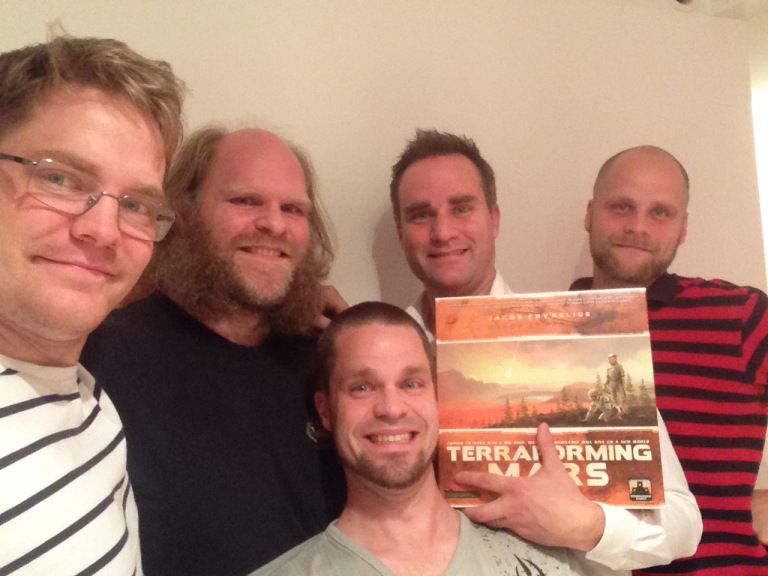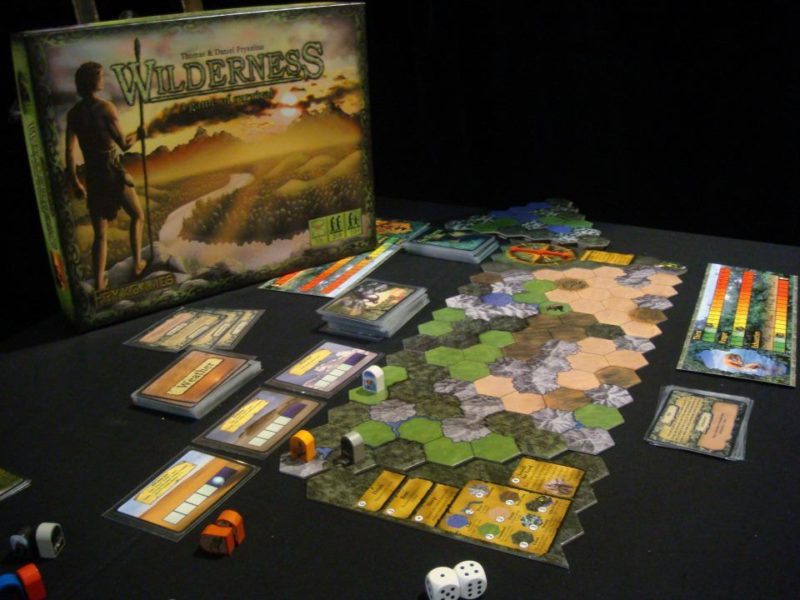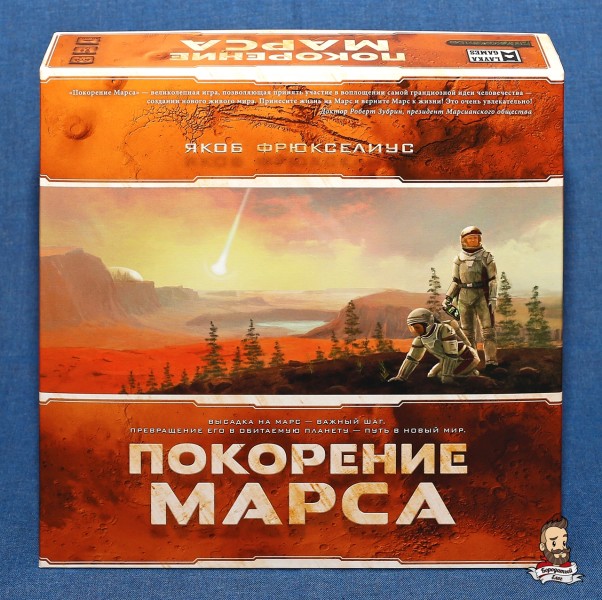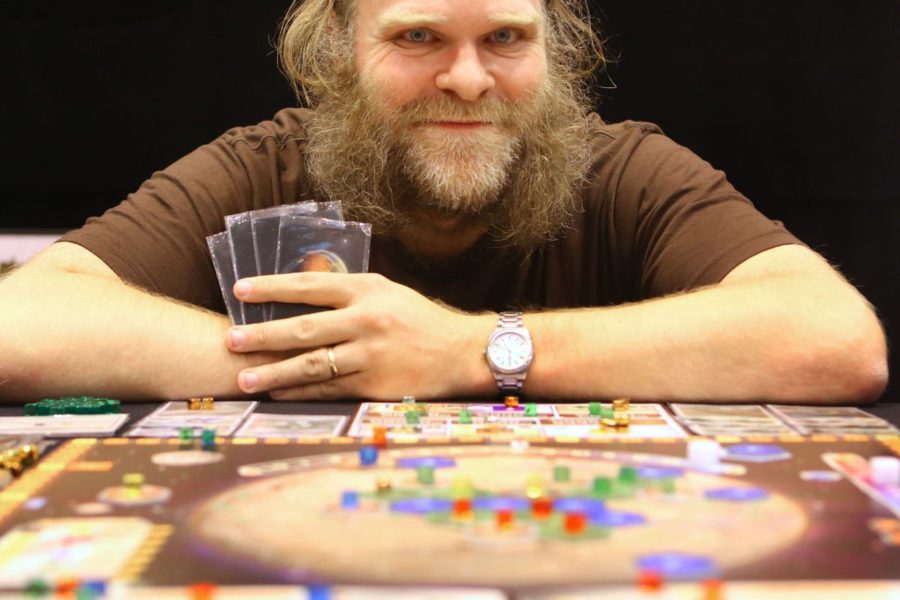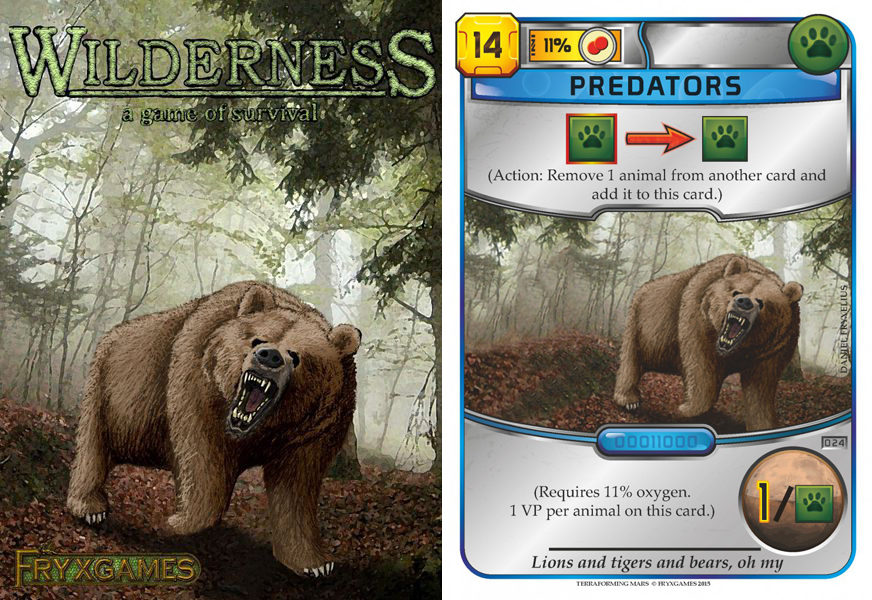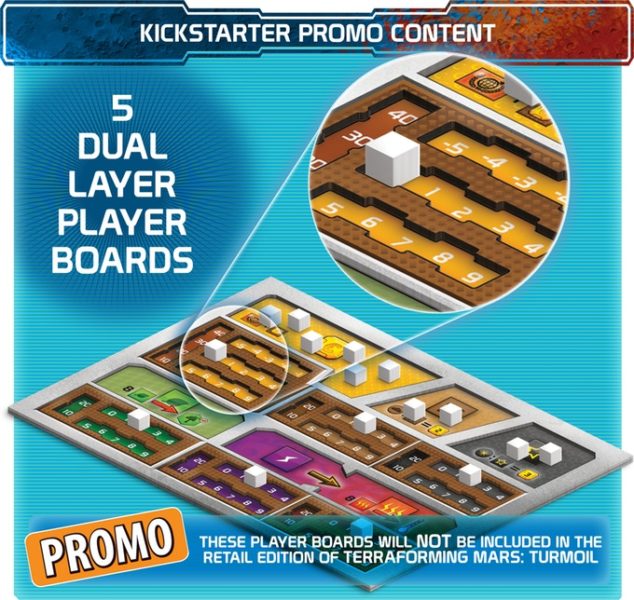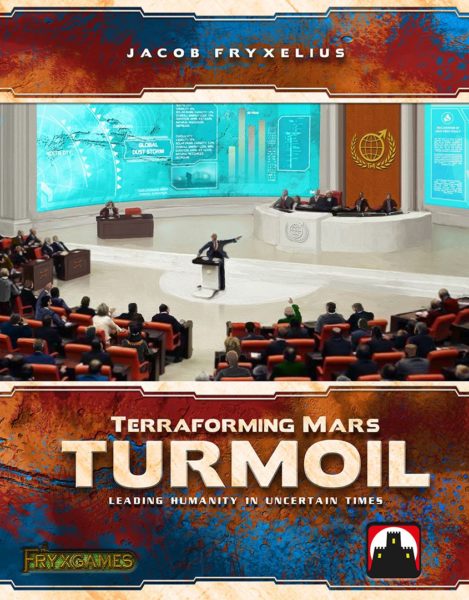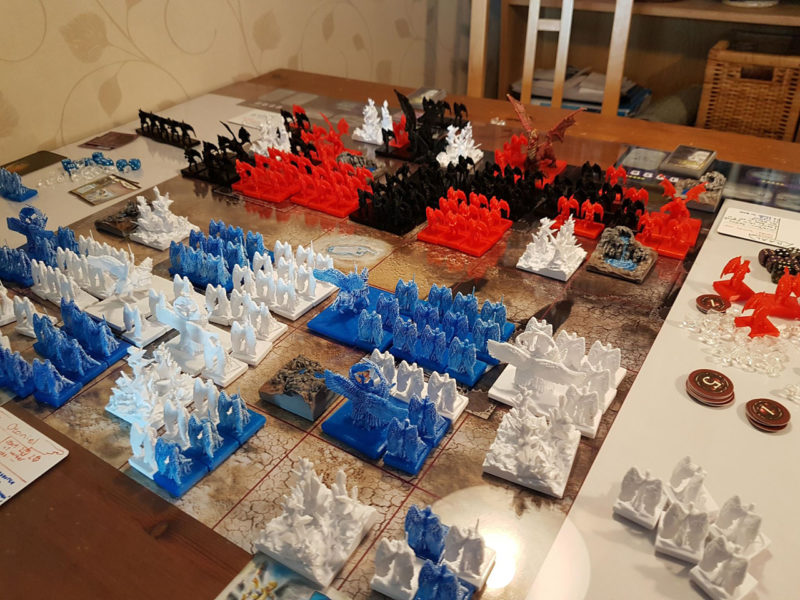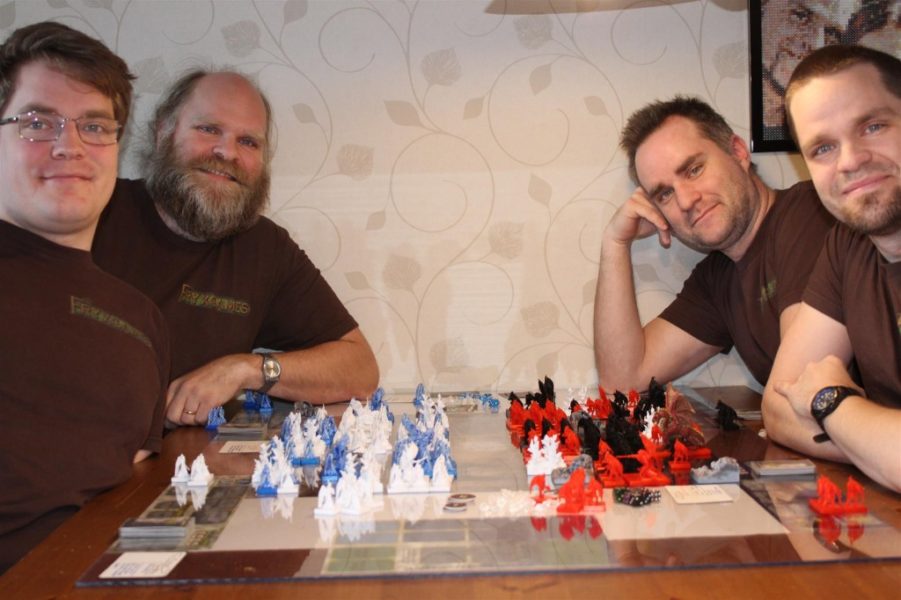It would be reasonable to assume that many board gamers at least heard of «Terraforming Mars». And this assumption would be justified. The game by Jacob Fryxelius stays popular three years after its release. (Though it should be noted occasional release of expansions helps this too.) Given such popularity, it was inevitable that we attempted to contact its author. Then one day we decided to do it.
While Jacob happened to be (understandably) very busy, instead we started a conversation with one of his brothers, Jonathan, who is also a member of FryxGames. Jonathan turned out to be very interesting to talk to and openly answered our tricky and not so tricky questions related to the game and some of its alleged issues (with some help from his brothers). Though it all resulted in a rather long interview, we decided to keep almost every single word out of it. So without any further ado, we give the floor to Jonathan Fryxelius.
Hello Jonathan. Thank you for agreeing to do this interview. First, tell us a little about yourself.
Hi, nice to meet you! My name is Jonathan Fryxelius, a 29-year-old father of 3 (in November). I have a bachelor’s degree in computer science from Karlstad University, and my hobbies – apart from making and playing board games – includes programming and performing with fire juggling.
How long have you been into board games? What spurred this interest?
We are ten brothers and six sisters. We all grew up playing board games. One reason was the lack of a TV, another reason was our very educational father, who created board games to use as learning tools. He especially likes to create simulations in board game formats, so it came naturally for us to create, mod, and play board games. But I think that we all approach game design from different angles. I love game systems, and how they can be used to simulate reality in elegant ways. Daniel is more focused on the theme, a story to come alive through the game. Jacob makes the best of both worlds as he makes elegant systems that also convey a strong theme.
What gave you the idea to try your hand in game design?
The obvious answer would be that we always had someone to play with, and our financial situation was lacking, so we didn’t buy a lot of new games. But I actually believe that one of the most important factors was that we have a lot of different creative talents in the family. Some of us are storytellers, others are illustrators, others are analysts, and all of us love creative work, so developing a board game involves many of us. I especially remember working on one of my prototypes. Me and Benjamin came up with the idea, so I started to invent new card ideas, Benjamin made some card templates, Thomas illustrated the cards, Peter and Jacob came along to try the game out and give their feedback. It didn’t take long before the game was the main thing we did in the evenings, sitting together around the kitchen table with pieces of paper, making a game from nothing.
When and why was «FryxGames» founded?
Up until 2011, we made games for private use. We made them to play them with family and friends, and were quite content with that. Thomas and Daniel had developed a game named Wilderness, based on a survival simulation our father made back in the 80s, and they had even tried to get it published through Swedish board game publishers, but without any luck. Even though we knew we were getting better at making games, we never really thought it would be more than a hobby at that time.
Until another creative brother stepped up. Our brother Enoch has always enjoyed playing the games we’ve made, but he has never made a game of his own. But he is a true and dedicated entrepreneur, and he saw the potential in our games. When the family was gathered (for a sister’s wedding, that’s the only time all of us are gathered now that we’re all grown up), he took the chance to invite anyone interested to a meeting to discuss taking game making to the next level. Four brothers showed up, it was Jacob, Enoch, Daniel, and me. There, we decided to start a family company and try to publish our own games. This was the summer of 2011, and in the autumn, «FryxGames» was a reality.
As I understand, the main employees of «FryxGames» are the Fryxelius brothers. How does this affect business matters?
Yes, the four of us are the owners, and our brother Isaac has joined us and is also working part-time in the company. Being brothers, we can come at each other pretty hard sometimes, but I think the overall experience is overwhelmingly positive. As in any relationship, communication is key.
What responsibilities each of the brothers have?
This is a topic we still discuss sometimes. Some responsibilities have been naturally assigned to each one of us. Enoch has always been the accountant, the business man who deals with factories and other publishers. Daniel and Isaac have always been the artists, I have always been the IT communications guy to handle our website. Isaac handles all production files for Terraforming Mars. Jacob and Daniel are the most productive game designers, generating new ideas faster than we can release them. Other responsibilities shift, or are not explicitly stated.
How difficult is it to deal with all aspects, starting with design and up to production?
The first game we produced, «Wilderness», was very difficult, since we had to learn so much that we had no experience of. The game itself had developed over 20 years, and much of the graphics was already done, but all the administrative work around it, and getting all the production files ready for the factory was a lot of work. That process is much more fluent now, but now we have other obstacles to overcome instead, for example how to keep track of 20 different language editions of «Terraforming Mars».
«Terraforming Mars» is a definite and well-deserved success, so congratulations are in order, if a little late. The game sits comfortably at the 3rd place in Top 100 and doesn’t seem to go anywhere soon. Could you tell how the idea for the game appeared? How was the game created?
Jacob is the creative mastermind behind the game, but the idea to make Mars a habitable world has been around for decades. Jacob has always been a board game geek, a science geek, and a Mars geek, so he combined all that geekiness to create something spectacular. He got the idea in 2011, after we had visited Essen Spiel for the first time. He started making notes on small pieces of paper that became the first cards in the game, and by Christmas, he had made the first prototype of the game and showed it to us. It took 5 years from those first ideas to the final product, and it was transformed from a card game to a card-driven board game.
One of the most interesting elements of «Terraforming Mars» are unique cards comprising the game deck. How difficult was it to create and balance all of them?
This is where Jacob’s analytical skills come into play. He has made a formula for the cost of each card. Everything you can gain on a card has a worth, so when adding up the worth of the card, you get the cost. I will not go into any details, but I can assure you that Jacob has thought this through really hard, to get all the factors into the formula. Some cards have effects which are hard to quantify, though, and some cards, even though they seem balanced from the formula, has proven to be too good or too bad, so they have been altered slightly. So we base the card costs on the formula, then we playtest to see if any changes need to be made. And it has worked fine! We have reprinted the game several times, and even though there are a few cards which we would change slightly if we made the game from scratch, we haven’t updated the values of any card throughout the prints, and that feels awesome.
Wouldn’t it have been better to do several card decks for different levels of progress instead of a single deck? This way only useful or suitable cards would come to the player’s hand at various stages of the game.
This is a common suggestion, but there are a lot of problems with that. For example, many cards are not easily categorized into a specific time in the game. There are a lot of cards that are good all throughout the game, and which deck would those be in? Secondly, there is no telling what really is «late» in a game of Terraforming Mars. In some games, all the oceans come out quickly, in others the temperature scale gets completed early. Some games only last 8 generations, others last 14 generations. Thirdly, having the game do your long-term strategy for you is not what we have in mind. If you get a card that is better later, then you should be able to prepare to play it later, or make sure that «later» becomes «sooner» by affecting the parameters needed. A fourth reason is to not get bogged down in a 30-minute setup time for the game, where you would need to separate all the 200 cards into the decks again before each match. There are even more reasons, but still, we get this suggestion a lot. It feels like people are only saying «You should be doing what everybody else is doing», but I think it is safe to say we were right in making something different.
Unfortunately, not all is enamored with the unusual design of the cards, which varies from computer-generated images to what look like images from the Internet. Why this style was chosen? What was the artist’s intent?
First, we need to separate the graphical layout from the illustrations. We’ve got almost nothing but praise for the graphical layout, that is, the iconography, the card frames, the color schemes etc. The complaints have mainly been about the various styles represented in the illustrations on the cards. In a game with over 200 unique cards, illustrations are a big part of the work, so we had to put a lot of effort into thinking it through. Jacob has always been pushing the theme of the game, that he wants each illustration to give a realistic idea of what such a project could look like. But when you shuffle through the 200 cards, you realize the illustrations would have to depict almost every category of thing we could think of. From entire planets down to single-celled bacteria, from the ordinary grass to the extraordinary impact of a moon on Mars, from the visible building industries to the invisible solar wind power. How could we possibly rely on a single form of illustration to properly convey all these things? One media that is trying to cover all those topics, is scientific magazines, and they use any and all forms that happen to prove useful to depict their ideas. In short, what is being portrayed is more important than how it is portrayed.
There is also a major influence from previous decades’ science fiction novels and visions about a future space-faring human species, that have left a large impact on this game, so we have tried to include some of the images from that time, which are nostalgic for us, and probably for many more.
Making the graphics for «Terraforming Mars» has been a huge project, and my brother Isaac, who is the main artist, has made a tremendous work to compile all these illustrations. We are very happy with the images used. They do their job well.
Speaking of influences and inspirations. «Terraforming Mars» contains multiple references to the trilogy written by Kim Stanley Robinson. What is your opinion on the author’s views? What else would you recommend to read?
The «Red Mars» trilogy by Kim Stanley Robinson is a fascinating read, primarily because of the realism portrayed about Martian colonization and terraforming. It has been a great inspiration for the game even if the author and I have very different views on for example politics, religion and what constitutes a satisfying read (reading the thoughts of crazy people is not my thing). In the same way, Robert E. Heinlein has been a major inspiration, not for the game specifically, but for sci-fi in general, but can also be over the top for me sometimes. He does have a knack though for taking an idea and draw a whole world of conclusions from that idea. His book «The Moon Is a Harsh Mistress» is very nice example of that.
Many players didn’t like thin and flimsy player boards. They can be easily flipped with a puff of air, leading even to stopping the game. Was this done on purpose, in order to reduce the cost of the game? Why haven’t you done something similar to the boards you offered during the Kickstarter campaign for «Turmoil»?
You are correct that the player boards have probably caused the largest complaints with this game. The choice of player board is not an easy choice, and the layperson will probably not understand what factors need to be weighed in. And there is no metric we can use to measure what a «good» player board is. That is probably why – when you look at the many different third-party options there are – they are not solving the same «problems», and they are not solving them the same way. There is no consensus on what the best solution is, and each solution has downsides.
We used a sturdy cardstock for the player boards. That has historically been the most common approach to making similar boards, we did not expect to get the heat we got for making something so commonly found in board games. I think a lot of the critique was due to the fact that «Scythe» had just been released, and they had made deluxe player boards with dual layer punchboard. We were instantly measured against the standard of a well-funded Kickstarter project, of which the designer has himself stated that the player boards were much too expensive to become common in the board game industry.
The reasons to choose the sturdy cardstock for the boards were many, and one of the main reasons was that is stays flat. We’ve heard countless of cases where punchboards warp, and a warped player board in «Terraforming Mars» would be devastating. Warping is generally caused by moisture in the air, but that could happen in any part of the distribution chain, so it is out of our own control, but we would be the target of any such complaints anyway.
In the «Turmoil» Kickstarter, we’ve made our own version of dual-layer player boards. It has taken a lot of time, and a lot of discussion to end up with the ones we’re making now. We’ve looked at the third-party options, we’ve listened to the feedback we’ve got, and we’re satisfied with the design. Now we just hope they don’t warp, and don’t cause more complaints than they were made to silence.
How long do you plan to release expansions for «Terraforming Mars»? How many more ideas do you have for those?
This is probably the first time «FryxGames» officially speaks out on the matter. «Turmoil» is the last planned expansion. We’ve had more ideas, and the fan community is generating some pretty interesting ideas as well, but we will have to move on to our other game projects at some point, and with «Turmoil», we feel the Terraforming experience is quite complete. We had one more small expansion planned, but for the moment, we’re dropping that idea. There is nothing stopping us from creating another expansion in a few years if the demand is high, but for now, we have many other projects to pursue.
There was information you planned to develop the «Terraforming Mars» brand. It seems that you’re developing the dice version of «TM» and even a Legacy version. Is this correct? Anything you can share about these products?
We’ve been overwhelmed by the success of «Terraforming Mars», and we can’t help but to expand the ideas around it. At the same time, we feel we need to be careful, so that we keep up the quality of the games and expansions we produce. We are indeed working on a dice version of the game, scheduled for Essen 2020. It aims at the same thing many other dice versions do; to make the game easier, shorter, smaller, yet maintaining the look and feel of the game. Something like a light version, or a travelling edition. As for legacy, that is mostly a rumor. With the 2 highest-ranked games in the world being legacy games, we have of course thought about making a legacy version. But there really is nothing to tell at this point.
Do you have any other games in development that are not related to the ‘TM’ brand?
Yes, we have many games in our pipeline. The next one is probably Daniel’s game «Angels & Demons». It has nothing to do with Dan Brown’s books, mainly because his books have nothing to do with angels and demons. No, this game is a war game with over 200 miniatures.
100 angels battle 100 demons over a man’s soul. It is a truly unique and well-made game which is coming to Kickstarter next year, if everything goes well.
After that, it is finally time for my 10-year-project to come to an end, a cooperative miniature board game named «Fate – Defenders of Grim Valley». So, we have interesting times ahead of us.
Given your current preoccupation do you have time to play board games for fun?
Well, I still think our games are fun to play, even after hundreds of plays. I heard someone say that a game designer must play his game until he is sick of it, then play it some more, but I don’t agree. You should be able to play your games with satisfaction for a long time, if it is a really good game. Sometimes you add in prototype expansions to spice it up a bit, but if you get bored with your game, then your customers will too, most probably. If you mean other board games than our own, then no, for me, I almost never play other games than the ones we are currently developing. There’s very little time. I know Enoch and Daniel are trying to play other games when they get time, but quite frankly, I’m usually not interested. I find developing games is more fun than just playing them.
Can you name some of your favorite games? What is it you like the most about each of them?
I can tell you some of the games that have left a great impression in my way of thinking about board games. Being a card gamer at heart, I really like «Dominion». I’ve also played «World of Warcraft TCG» a lot, the card game that turned into «Hearthstone» later. I also like the time management genre, so I am quite fond of «Escape – The Curse of the Temple».
On the other hand, are there any games that disappointed you? What games would you never play in your life?
«Monopoly», of course. «Lord of the Rings, the living card game» was also a disappointment. Without making a long list, I would argue that games without any theme, or games where the rules are heavier than what they allow, are no good.
Thank you for all the answers, Jonathan! Good luck to FryxGames with all the upcoming projects.
Illustrations taken from the official site of «FryxGames» and from BoardGameGeek.


